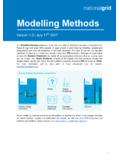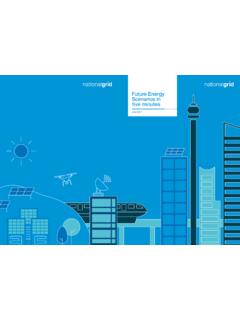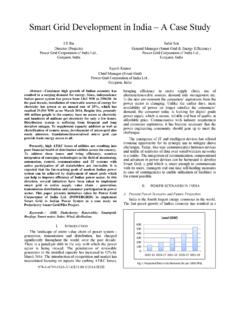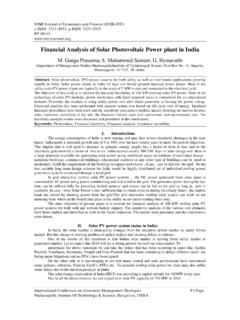Transcription of Future Energy Scenarios
1 Future Energy Scenarios July 2017 aFuture Energy Scenarios July 2017 cCCSF uture Energy ScenariosJuly 2017 Future Energy Scenarios July 2017 Future Energy Scenarios July 2017 HomeThis will take you to the contents page. You can click on the titles to navigate to a section. ArrowsClick on the arrows to move backwards or forwards a page. A to ZYou will find a link to the glossary on each page. HyperlinksHyperlinks are underlined and highlighted in the chapter colour throughout the report. You can click on them to access further information. How to use this interactive document To help you find the information you need quickly and easily we have published the FES as an interactive document. Future Energy Scenarios July 2017 01We are in the midst of an Energy revolution. The economic landscape, developments in technology, evolving business models and consumer behaviour are changing at an unprecedented rate, creating more opportunities than ever for our industry.
2 Our Future Energy Scenarios , along with our other System Operator publications, aims to encourage and inform debate, leading to changes that ensure a secure, sustainable and affordable Energy Future . Last year I said that we were in the midst of an Energy revolution, and this year it is even more evident. Since last year the political landscape has changed we have seen the US withdraw from the Paris Accord, a general election in the UK and the continued uncertainty of the UK leaving the European Union. Coupled with this, we are seeing many developments which are disrupting the traditional Energy status quo today, such as an ever changing and divergent Energy mix. Plus developments in technologies such as electric vehicles, smart devices and consumer behaviour change, to name but a few, which will impact in the Future . All of this leads to the requirement for more flexible Energy this backdrop it is impossible to forecast a single Energy Future over the long term.
3 By providing a range of credible futures in the Future Energy Scenarios , it allows us to support the development of an Energy system that is robust against a range of outcomes. This year we have enhanced our modelling, have richer economic forecasts and have extended the use of our Scenarios to 2050. We have also pushed the envelope wider by including a number of possible futures in our sensitivities that test hypotheses beyond our traditional remain focused on understanding the Energy revolution, and this year our publication provides even greater insight than previously. I hope that you find this document, along with our other System Operator publications, useful as a catalyst for wider debate. For more information about all our publications, please see page 9. Your views, knowledge and insight have shaped this publication, helping us to better understand the Future of Energy . Thank you for this valuable input over the past year and please continue to share your views with us; you can find details of how to contact us on our website: Marcus StewartHead of Energy InsightsFuture Energy Scenarios July 2017 02 Executive summary.
4 03 Key messages ..04 ContentsChapter fourIntroduction .. The 2017 Scenarios .. EU Referendum .. How to use the FES document suite ..12 Scenario descriptions .. Two Degrees .. Slow Progression .. Steady Consumer Power ..17 Scenario development ..18 Energy supply .. Energy supply ..50 Electricity supply .. Electricity supply .. GB generation ..56 Spotlight Electricity operability .. Sources of flexibility ..64 Spotlight Emerging technologies Energy supply ..74 Gas supply .. Gas supply .. Sources of gas ..79 Spotlight Transit gas GB .. Peak gas supply ..83 Spotlight Gas operability ..86 Chapter fiveChapter sixSensitivities .. Introduction to sensitivities .. Decarbonised gas .. High electric vehicles .. Consumer renewables .. High electrification ..105 Glossary ..110 Energy demand .. Energy demand .. Industrial and commercial demand .. Residential demand .. Transport demand ..40 Spotlight Emerging technologies Energy demand.
5 46 Chapter oneChapter twoChapter threeFuture Energy Scenarios July 2017 03 Executive summaryNational grid has an important role to play in leading the debate on the Energy revolution across the industry and working with our stakeholders to ensure that we have a safe, secure and reliable Energy System Operator (SO), we are perfectly placed to be an impartial enabler, informer and facilitator. The SO publications that we produce every year are intended to be a catalyst for debate, decision making, and change as well as providing transparency to the wider industry. The starting point for our SO publications is the Future Energy Scenarios (FES). The FES is published every year and involves input from stakeholders across the Energy industry. This year we have enhanced our stakeholder engagement activities and we consulted 391 organisations, increasing our engagement from 362 in 2016. The Scenarios are based on the Energy trilemma (security of supply, sustainability and affordability) and provide credible pathways for the Future of Energy for Great Britain (GB) out to 2050.
6 It is hard to have missed the significant amount of change on economic, political and technological fronts over the past year s analysis shows us electric vehicles (EVs) could drive large increases in peak demand if we continue to see the sharp uptake past the 2030s and if there is no management of when charging occurs. Decarbonising heat remains an area that is difficult to progress and our Scenarios cover a range of approaches to heating, from incremental to fundamental changes. There is no one solution for the heating dilemma but in our Two Degrees scenario, which meets the 2050 carbon reduction target, the use of gas boilers declines considerably by 2050 and is overtaken by heat pumps, supported by improved house heat see an increasing diversity of generation sources becoming available and technology driving growth in the Future . Innovation in information communication technology (ICT) is allowing new opportunities to emerge such as residential and commercial Energy generation, and smart devices that use and provide data to communicate quicker and easier than ever before.
7 Our analysis points to some important themes and messages. Future Energy Scenarios July 2017 04 Executive summaryAn Energy system with high levels of distributed and renewable generation has become a reality. This growth is set to continue, increasing the complexity of operating a secure and cost effective Energy system. The total amount of renewable generating capacity was 34 GW in 2016, making up 34 per cent of total installed capacity. In Two Degrees this could increase to as much as 110 GW or 60 per cent in 2050. In 2016, installed capacity from distributed generation reached 26 GW or 27 per cent of total installed capacity. Looking forward to 2050, this could increase to a total of 93 GW or 50 per cent in Consumer Power. As traditional sources of Energy supply are replaced by new ones, and demand becomes more dynamic, the Energy system will be more complex to manage. Responsive balancing products and services will be needed to deliver flexibility across both the electricity and gas technologies and evolving business models are rapidly transforming the Energy sector.
8 Market and regulatory arrangements need to adapt swiftly to support a flexible Energy system with an increasing number of participants. There are rapid changes in technologies and approaches such as battery storage, electric vehicles and demand side response. Electricity storage capacity totalled 4 GW in 2016 and this could grow rapidly to almost 6 GW by 2020. The Energy sector is becoming more diverse with a move away from a small number of large companies, to a wide range of smaller providers and innovators. Effective facilitation and investment will be required to achieve an agile, coordinated and accessible Energy market that delivers value for messagesFuture Energy Scenarios July 2017 05 Electricity demand has the potential to increase significantly and the shape of demand will also change. This is driven initially by electric vehicles and later on by heat demand. It will require a range of solutions to deliver the best value for consumers, including a coordinated approach across the whole system; investment in smart technologies, transmission and distribution infrastructure; and commercial approaches such as consumer behaviour change.
9 Electricity peak demand could be as high as 85 GW in 2050, compared to around 60 GW today, driven by a number of factors. Electric vehicles are projected to reach around one million by the early 2020s, and there could be as many as nine million by 2030. Without smart charging, this could result in an additional 8 GW of demand at peak times. Heat pump demand may also add to this. If weather patterns continue to change, air conditioning could raise peak demand in summer to a similar level to winter towards the end of the scenario period. Away from peak demand periods the increase in distributed generation, in particular solar, could lead to periods of very low demand on the transmission system. Gas is critical to security of supply now and as Britain continues the transition to a low carbon Future . It will have a long-term role as a flexible, reliable and cost-effective Energy source favoured by many consumers. Gas provides value to consumers and the whole Energy system.
10 It supplies more than twice as much Energy annually as electricity today and could still provide more Energy than electricity in 2050. Gas infrastructure is ageing and the demands on it are also changing, requiring a more flexible system. It will need to be maintained or adapted, and it is likely that some upstream entry and further storage facilities will close over the scenario period. In order to meet the 2050 carbon reduction target, decarbonisation of heat needs to pick up pace now. Gas will continue to play an important role in this transition and beyond with new technologies and the potential use of hydrogen. It also offers worthwhile carbon reductions in the power sector in the interim. Traditional sources of gas are declining. There are plenty of options for providing a continuing supply of gas, from the world market and from novel sources within GB. Some of these may require innovative approaches to connecting and transporting gas.








